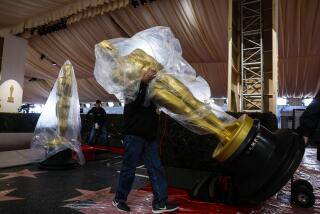Gene Allen dies at 97, won Oscar for “My Fair Lady,” sped up Academy Awards
Gene Allen spent six months on the street as a patrolman for the Los Angeles Police Department but decades on movie sets as an Oscar-winning art director and production designer, most notably for director George Cukor.
Allen won an Oscar for his work on Cukor’s “My Fair Lady” and for three years was president of the Academy of Motion Picture Arts and Sciences, which produces the annual Academy Awards broadcast.
He died in a hospital Wednesday of natural causes, according to an announcement from the Art Directors Guild. Allen, who lived in Newport Beach, was 97.
After ratings dropped for the lengthy annual Oscars presentation, Allen aimed to give it a livelier, more contemporary look. With a committee composed of actor Gregory Peck, screenwriter Larry Gelbart and director Robert Wise, he winnowed down production numbers, leaned on participants to give shorter speeches and managed to trim a ponderous four hours to a sprightlier three.
In a tongue-in-cheek 1985 review, Los Angeles Times critic Howard Rosenberg complained that the brisker pace left “no time for an abrasive political speech, or even a streaker. There was no time for the traditional foolishness that you love to hate. Jack Lemmon was a flop as the primary host because he failed to tell one bad joke.”
“The Oscar telecast was born to bore,” Rosenberg wrote. “It’s unethical to tamper with failure. It’s unholy. It’s criminal. Now look what’s happened. The Oscar telecast is good.”
It wasn’t Allen’s first success.
In addition to “My Fair Lady” (1965), he received Oscar nominations for two other Cukor films: “A Star is Born” (1955) and “Les Girls” (1958).
In 1971, he took a temporary job as executive director of the Society of Motion Picture and Television Art Directors. It lasted 27 years. In 1998, he “was reminded by a much younger membership that it was time for me to retire,” he wrote in an autobiographical essay.
The society later became the Art Directors Guild.
He was president of the Academy of Motion Picture Arts and Sciences from 1983 to 1985.
Born in Los Angeles on June 17, 1918, Allen graduated from Fairfax High School and was hired in the blueprint room at Warner Bros. Within a year or two, he was an apprentice sketch artist.
“As long as I could remember, I’ve loved the feeling of a soft-leaded pencil applied to a drawing pad,” he wrote.
But, discouraged over repeated layoffs at the studio, he changed direction. Ignoring the advice of his father, a Los Angeles police captain, he joined the LAPD and patrolled West L.A., where, he wrote, he “enjoyed seeing bits and pieces of the other side of life.”
World War II cut short his time in law enforcement. After serving in the Navy, he enrolled full time at Chouinard Art Institute. Soon, he was teaching there, selling his watercolors of red barns in the snow to department stores and picking up jobs at the studios.
His production design credits include “The Chapman Report” (1962), “The Cheyenne Social Club” (1970), and “At Long Last Love” (1975). The films he art-directed include: “Let’s Make Love,” “A Breath of Scandal,” and “Heller in Pink Tights,” all released in 1960; and “Back From Eternity” and “Bhowani Junction,” released in 1956.
In the 1980s, Allen was a consultant to Color Systems Technology, a company that colorized old films for the Turner Broadcasting System.
While the practice was decried by some in the industry, Allen said it helped preserve film heritage.
“This new process is a way to bring these films to millions of new viewers -- a generation that has grown up on nothing but color,” he told the Times in 1987. “I see nothing wrong with that.”
Allen said his advice to the company was “only about color basics, such as the differences in blueness of a sky in England and the Caribbean.”
He continued painting well into his later years.
In addition to his wife Iris, he is survived by sons Pat and Mike.
More to Read
Start your day right
Sign up for Essential California for the L.A. Times biggest news, features and recommendations in your inbox six days a week.
You may occasionally receive promotional content from the Los Angeles Times.







